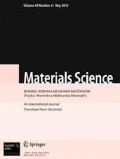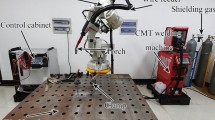We study the cyclic crack resistance of the metal of welded joints of 34KhN2MA thick-plate steel obtained with the help of ferritic and austenitic electrodes. It is shown that the weld metal has a higher crack resistance than the base metal only within the second part of the kinetic diagrams of fatigue fracture. In the first and third parts, the characteristics of the weld metal are worse. The results of fractographic investigations demonstrate that the decrease in the fatigue crack-growth resistance in pure austenitic welds is explained by the presence of hot cracks in the zone between the near-root metal of the welded joint and the base metal. As for the mixed ferrite-austenitic welds, the decrease in the fatigue crack-growth resistance is explained by inadmissibly large slag inclusions creating additional stress concentration and deteriorating the characteristics of cyclic crack-growth resistance.




Similar content being viewed by others
References
E. N. Berdnikova, “Structural evaluation of the crack resistance of welded joints of high-strength steels,” Probl. Mashinostr., 16, No. 6, 43–47 (2013).
V. I. Makhnenko, Period of Trouble-Free Operation of Welded Joints and Units of Contemporary Structures [in Russian], Naukova Dumka, Kiev (2006).
V. D. Poznyakov, V. A. Kostin, A. A. Gaivoronskii, I. A. Mossokovskaya, V. V. Zhukov, and A. V. Klapatyuk, “Influence of the thermal cycle of welding on the structural phase transformations and properties of the metal of the heat-affected zone of 30Kh2N2MF medium-carbon alloyed steel,” Avtomat. Svark., No. 2, 8–15 (2015).
J. S. Seo, H. J. Kim, and H. S. Ryoo, “Microstructure parameter controlling weld metal cold cracking,” J. Achiev. Mater. Manuf. Eng., 27, No. 2, 199–202 (2008).
Yu. A. Sterenbogen, “Some factors determining the resistance of the metal of heat-affected zone of martensitic steels to the formation of cold cracks,” Avtomat. Svark., No. 6, 5–8 (1986).
V. Yu. Skul’skii, “Specific features of the kinetics of slow fracture of welded joints of hardening steels,” Avtomat. Svark., No. 7, 14–20 (2009).
A. A. Gaivoronskii, V. A. Sarzhevskii, and V. G. Gordonnyi, “Weldability of 38Kh2MYuA medium-carbon alloyed steel,” Avtomat. Svark., No. 4, 20–24 (1997).
O. P. Ostash, A. V. Kunovskii, V. E. Laz’ko, N. S. Guseva, T. L. Maksimovich, and L. V. Kazakov, “Cyclic crack resistance of welded joints of high-strength steels,” Avtomat. Svark., No. 7, 8–12 (1990).
L. I. Markashova, V. D. Poznyakov, E. N. Berdnikova, T. A. Alekseenko, and S. L. Zhdanov, “Structure and properties of the joints of high-strength steel under the conditions of external static loading,” in: Building, Materials Science, and Machine-Building [in Russian], PSABA, Dnepropetrovsk (2014), pp. 213–219.
L. I. Markashova, G. M. Grigorenko, E. N. Berdnikova, and T. A. Alekseenko, “Structural criterion of strength, plasticity, and crack resistance of metals, alloys, and composites and their welded joints,” in: V. V. Panasyuk (editor), Proc. of the Fourth Internat. Conf. on Fracture Mechanics of Materials and Strength of Structures (Lviv, 23–27.06.2009) [in Ukrainian], Karpenko Physicomechanical Institute, Ukrainian National Academy of Sciences, Lviv (2009), pp. 447–451.
S. Li, E. Akiyama, K. Yuuji, K. Tsuzaki, N. Uno, and B. Zhang, “Hydrogen embrittlement property of a 1700 MPa class ultrahigh strength tempered martensitic steel,” Sci. Technol. Adv. Mater., No. 11, 1–6 (2010).
P. Wongpanya, Th. Boellinghaus, and G. Lothongkum, “Heat treatment procedures for hydrogen-assisted cold cracking avoidance in S 1100 QL steel root welds,” Weld. World, 52, 671–678 (2008).
N. N. Kharbin, O. I. Sleptsov, M. N. Sivtsev, and G. G. Vinokurov, “Evaluation of the influence of hydrogen on the slow destruction of welded joints of high-strength low-alloy steels,” Avtomat. Svark., No. 6, 15–17 (20120.
N. P. Aleshin and G. G. Chernyshov (editors), Welding Cutting. Control. A Handbook [in Russian], Vol. 2, Mashinostroenie, Moscow (2004).
V. A. Osadchuk, L. I. Tsymbalyuk, and A. R. Dzyubyk, “Determination of the triaxial distribution of residual stresses in welded joints of structural elements by rectilinear welds and estimation of their influence on the strength of joints in the presence of crack-like defects,” Mat. Met. Fiz.-Mekh. Polya, 54, No. 1, 131–140 (2011).
GOST 25. 506-85. Strength Analyses and Tests. Methods for Mechanical Testing of Metals. Determination of the Characteristics of Crack Resistance (Fracture Toughness) under Static Loading [in Russian], Goskomstandart SSSR, Moscow (1985).
Author information
Authors and Affiliations
Corresponding author
Additional information
Translated from Fizyko-Khimichna Mekhanika Materialiv, Vol. 54, No. 2, pp. 75–81, March–April, 2018.
Rights and permissions
About this article
Cite this article
Dzyubyk, A.R., Voitovych, A.A., Dzyubyk, L.V. et al. Specific Features of the Fatigue Fracture of Welded Joints of 34KhN2MA Steel Formed by Electrodes with Different Phase Compositions. Mater Sci 54, 215–222 (2018). https://doi.org/10.1007/s11003-018-0176-1
Received:
Published:
Issue Date:
DOI: https://doi.org/10.1007/s11003-018-0176-1




